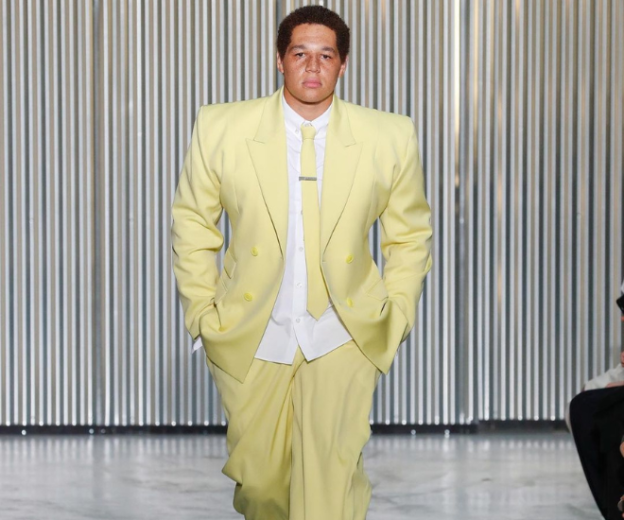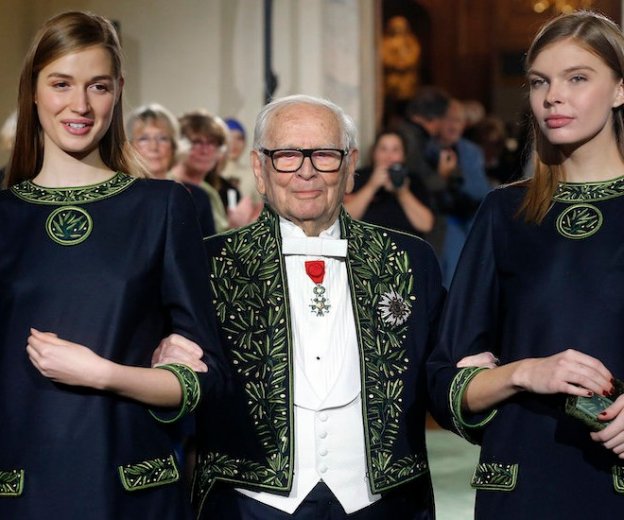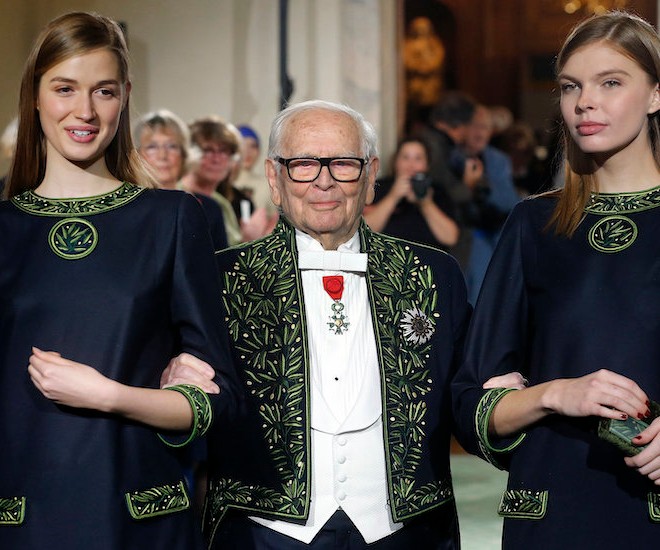
It is no secret that the fashion industry has a history of favouring and designing for unrealistically slim figures. However, in the last decade, the plus-size market has seen notable growth reflected by the presence of more plus-size models on runways and in campaigns. Many brands and retailers have jumped on the inclusive sizing bandwagon to satiate calls for inclusivity and diversity, but this seems to exclusively apply to womenswear.
Given that female consumers dominate the luxury fashion market, males — more particularly plus-size males — are often overlooked due to the commercial risks. In the current social landscape, females have been particularly vocal about the need for size inclusivity, fostering a rapidly evolving social movement of body positivity. Their demands had prompted expanded size ranges with many brands, while this may be performative and a tool used to increase profits, this still grants more freedom to shop a wider range of styles.
The same cannot be said for males. Despite advancements in female size inclusivity and beyond the glitz and glamour of high fashion, lies a deep disparity and disregard for size inclusivity in menswear. This begs us to ask the question: What about men’s size inclusivity? And where are the male plus-size models? LUXUO examines the untapped male plus-size market and fashion’s shortcomings in inclusivity.
Read more: Method Dressing: Hollywood’s Favourite Box Office Booster
Luxury Labels’ Reluctance to Expand Size Ranges


The current state of plus-size representation in menswear is exceptionally underwhelming, with little prominence in high fashion labels and a severe lack of data regarding the plus-size menswear market despite a large population. According to a study done by Iowa State University, plus-size men make up 70% of the United States population and 40% of men have issues with size and fit. The global plus-size market has reached a value of US 288 billion in 2023 and is expected to exceed 500 billion by 2033.
By taking these statistics into consideration — even with significant growth potential for brands and such a large demographic unprovided for — why does the fashion industry overlook this population? Perhaps the patriarchal and somewhat narrow-minded vision of masculinity in menswear. The fashion industry’s internalised fatphobia and general unwillingness to cater to large sizes are the root of plus-size lack of representation, states Kayla Merci, a retail analyst.
Furthermore, the lack of inclusivity in men’s fashion is highly driven by social beauty standards, often presented to the world through model representation on runways and campaigns. It is a known fact that designers create their garments based on a vision of a certain body shape and aesthetic, an image that typically perpetuates an unrealistically tall and slim ideal of the male body — resulting in a lack of representation in high fashion.
In Milan Fashion Week of 2023, it was found that just six of the 72 shows features at least one male plus-size model, with just 0.6%. While there is growing awareness, the dominance of the slender male physique leaves little room for anyone outside of this standard, making it almost impossible for this demographic to shop high fashion. It is also worth noting that numerous fashion retailers have extensive sizes ranges to cater to mass markets and to optimise profits, however, luxury labels severely lag behind due to a strict idea of “desirability” and commercial risks.
High end brands often cite financial and logistical reasons for not expanding their size ranges. Given that good tailoring is a pillar of menswear, designers claim that it is more difficult to accommodate larger sample sizes, hence the lack of representation in on runways. Commercial risks extend to creating diverse sample sizes and the complexities of catering to different body shapes in a variety of products, all of which require market research and product testing.
Furthermore, plus-size men are unable to shop luxury labels in-store, with their sizes unavailable on the rack nor on the displays — further distancing, marginalising and excluding plus size individuals. When catering to size, those of larger sizes tend to be limited to oversized silhouettes which are shapeless and somewhat typically untrendy and unexciting. Hence, the allure of luxury labels with a reputation of exceptional quality, prestigious name and tailoring, something that is seldom achieved from fast fashion purchases.
However, at the industry’s current state, men who do not conform to high fashion standards are granted little freedom to shop and forced to settle for ill-fitting fast fashion garments. Despite a large demographic and growth potential, inclusive fashion is more than a marketing tactic and a reality for many. In catering to this underrepresented population, thoughtful steps can go a long way in fostering a diverse and loyal customer base.
Read more: Beyond the Label: How Luxury Brands Leverage on Legacy Storytelling
Society and Cultural Norms

A significant contributing factor to note is that males are much less vocal about body image insecurities and take on a more stubborn stance when addressing masculinity norms. It is no secret that there is a massive population uncatered for, yet many perpetuate the traditional views of masculinity in not addressing self-esteem or body image issues. As examined by German newspaper Zeit, it was found that men generally placed more importance on other factors such as social status and wealth. The notion presents the idea that men do not have to meet the beauty ideal as it is not important. The stereotypical idea that males should focus on careers while females must adhere to strict beauty ideals, while extremely outdated is majority accepted till this day.
Therefore, many of those demanding for size inclusivity historically been marginalised due to their size. For the brands that have expanded size ranges, larger sizes have typically been categorised under the title “Big and Tall” which not only reinforces negative stereotypes but presents the idea that being “plus-sized” is stigmatised. Due to these factors much of the plus-size population remain underrepresented due to fear of societal stigma and pressure to adhere to the traditional idea of masculinity. Therefore, while unfortunate, high fashion labels may not feel the need to cater to larger sizes if the demographic does not demand for change on a mass scale. Without mass outcry, brands do not see profitability and are unlikely to expand size ranges.
Read more: Does Anyone Still Care About London Fashion Week?
Role of Social Media and Representation

The power of social media and digital marketing is undeniable. These platforms dictate the success of cultural movements, activism and give users a space to advocate and express. We have seen this with the acceptance of plus-size females and mass advocacy for size inclusivity. While there is a long way to go for female size inclusivity, we have seen a large shift in societal expectations, with an influx of diverse and inclusive fashion campaigns, runway models promoting a brand’s extensive size range. The younger generation has been the driver of this cultural shift, with more freedom to express, customer habits have become more informed with heavily emphasis of aligning social values when purchasing.



It has been proven that social media advocacy has successfully influenced extension of plus sized apparel, in hopes to appeal to the younger generation and to increase their customer base and profitability. However, the same cannot be said for men, despite numerous celebrities like Sam Smith, Jonah Hill and Seth Rogan highlighting the gap. Plus-size women in recent times have been empowered by the media, larger men are often portrayed as less desirable in film and adverts. While there has been some progress with Rihanna’s Savage X Fenty, Kid Super, Charles Jeffery Loverboy and LGN Louis Gaberiel Nouchi in showcasing plus-sized male models and a broader range of body types. While demographic of plus-size males is largely untapped, it possesses much profitability and potential which is often overlooked by brands due to a lack of-advocacy and customer demands. Just like the female population, males continue to struggle with self esteem and body image issues, and it is crucial to foster advocacy and representation to welcome more diversity in men’s fashion.
In conslusion, despite significant potential in the male plus-size market, this demographic is still largely underrepresented due to a lack of urgency in driving conversations about the importance of diverse male representation in fashion. While there is a long way to go with inclusivity in fashion as a whole, the progress made in female plus-size representation proves that when the public challenges the status quo, this raises awareness and encourages change. It is only then, luxury labels are likely to cater to male plus-size inclusivity and representation. Just like the female population, males continue to struggle with self-esteem and body image issues, and it is crucial to foster advocacy and representation to welcome more diversity in mens fashion.
For more on the latest in luxury fashion and style reads, click here.














